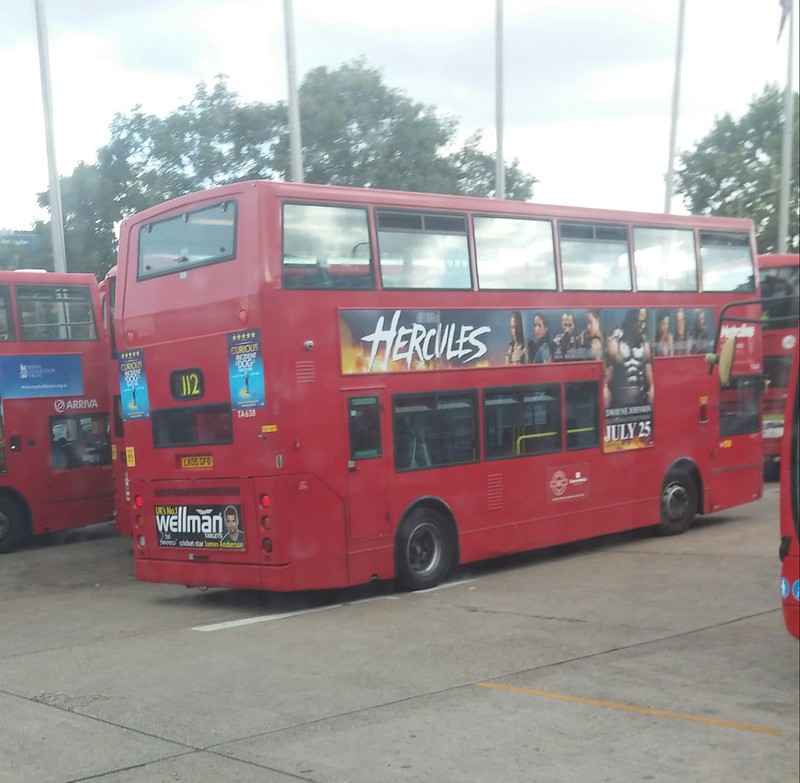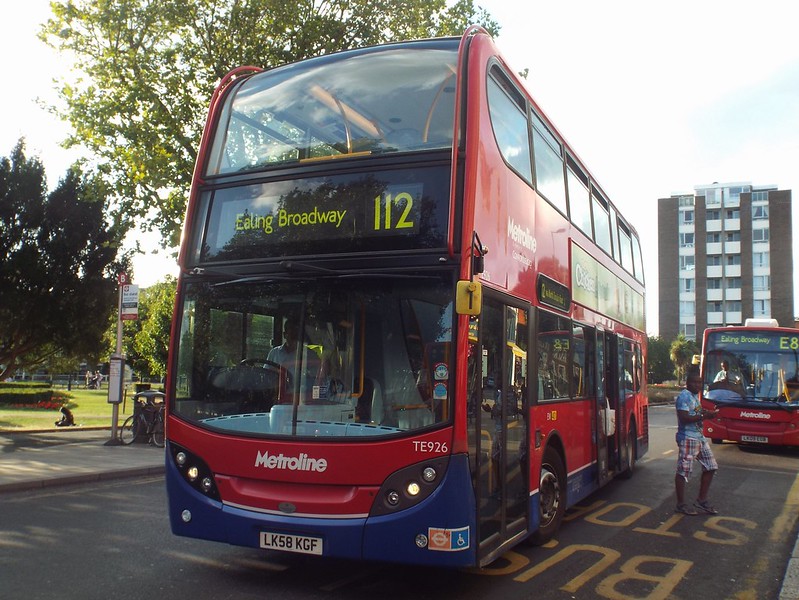The London Bus Blog goes flying
This post today isn't much to do with the form of Public Transport in Buses, but the form of public transport in aviation. This summer I went on Holiday using world famous Airline Emirates. They are known in London for sponsoring the construction of the "Emirates Air-Line" gondola lift in East London. They are also well known in London for sponsoring one of London's football clubs, Arsenal.
The plane that I was due to take would be from London Heathrow Airport (LHR) and would be an Airbus A380 "The Largest Airliner to take to the skies." Emirates flies 5 flights between London Heathrow and Dubai International (DXB). While I was waiting for my plane I saw another Airbus A380 next to us, this was one of Qantas' planes. Qantas is one of Emirates' key codeshare partners and both airliners fly to Dubai, with Qantas continuing to Sydney.
© EastLondoner 2014
 I got quite a few good pictures of this plane. This was at 7:30 in the morning and the plane was leaving to go to a remote stand as it wasn't due to depart London for quite a long time. As you can see in the picture, the Airbus A380s have 4 engines, quite big as well. It's unusual for a pretty new model to have 4 engines as 2 engines are usually more economical. But Airbus seem to have sorted the issue out and these Giants of the sky fly some of the world's longest routes.
I got quite a few good pictures of this plane. This was at 7:30 in the morning and the plane was leaving to go to a remote stand as it wasn't due to depart London for quite a long time. As you can see in the picture, the Airbus A380s have 4 engines, quite big as well. It's unusual for a pretty new model to have 4 engines as 2 engines are usually more economical. But Airbus seem to have sorted the issue out and these Giants of the sky fly some of the world's longest routes. These Qantas ones are powered by Rolls Royce Trent engines. Although the Emirates ones are powered by Engine Alliance engines. Although I don't think that you will be noticing much of a difference in flight. Emirates and Qantas are some of the Worlds largest A380 operators with Emirates having a total of 140 of these once its deliveries are complete and Qantas having a total of 20. Both Emirates and Qantas only use Airbus A380s on their London flights
These Qantas ones are powered by Rolls Royce Trent engines. Although the Emirates ones are powered by Engine Alliance engines. Although I don't think that you will be noticing much of a difference in flight. Emirates and Qantas are some of the Worlds largest A380 operators with Emirates having a total of 140 of these once its deliveries are complete and Qantas having a total of 20. Both Emirates and Qantas only use Airbus A380s on their London flights
While waiting for boarding I also saw a British Airways Boeing 777 and a Virgin Atlantic Boeing 747.
British Airways is the flag carrying airline of the United Kingdom and the biggest airline in the U.K by fleet size. It's parent company is the "International Airlines Group" who also operate Iberia Airlines. They form the fourth biggest airline in Europe. British Airways have their hub located at London Heathrow and Terminal 5 at the airport is dedicated exclusively for British Airways and Iberia planes.
Virgin Atlantic also have one of their Hubs located at London Heathrow airport, and in this picture you can see one parked at the other side of Terminal 3 along with a British Airway Airbus A319 heading to the Runway.
 I then left for my Holiday abroad. One of the other planes that I took was an Emirates Boeing 777-200. Here it is seen at Chennai (MAA) Airport, international terminal. I took it to Dubai International Airport. In Dubai international airport there isn't much variety to take pictures of. Once we landed we started making our way to Terminal 3, which is one of the World's largest Airport terminals. Terminal 3 at Dubai is used only by Emirates and Qantas planes. We arrived at Concourse A and we needed to board a mini underground metro which would take us to the main terminal building, where we would collect out baggage.
I then left for my Holiday abroad. One of the other planes that I took was an Emirates Boeing 777-200. Here it is seen at Chennai (MAA) Airport, international terminal. I took it to Dubai International Airport. In Dubai international airport there isn't much variety to take pictures of. Once we landed we started making our way to Terminal 3, which is one of the World's largest Airport terminals. Terminal 3 at Dubai is used only by Emirates and Qantas planes. We arrived at Concourse A and we needed to board a mini underground metro which would take us to the main terminal building, where we would collect out baggage.
Here we can see the newest Concourse at Terminal 3. Concourse A
Here we can see some Emirates Aircraft parked on the other side of Concourse A
Here is another shot of Concourse A
Here is an interior shot of the mini metro that is used in the Airport to shuttle people between Concourse A and the main terminal building.
 In a week, I returned to the Airport to make my way home to London. We managed to arrive at the Airport pretty early and I made use of the time by going around the terminal taking pictures of waiting planes. Funnily enough, almost all of the planes that I took pictures of were Boeing 777s. Emirates being the World's largest operator of the type. The plane flies to many destinations around the globe and some of their newer Boeing 777s also feature WiFi which can be purchased on the flight. In these pictures you can see them as they wait around the terminal waiting to take passengers to their needed destinations.
In a week, I returned to the Airport to make my way home to London. We managed to arrive at the Airport pretty early and I made use of the time by going around the terminal taking pictures of waiting planes. Funnily enough, almost all of the planes that I took pictures of were Boeing 777s. Emirates being the World's largest operator of the type. The plane flies to many destinations around the globe and some of their newer Boeing 777s also feature WiFi which can be purchased on the flight. In these pictures you can see them as they wait around the terminal waiting to take passengers to their needed destinations.
These planes have two airbridges connecting them to the terminal. One is used by First Class passengers while the other one is used by Economy and business class passengers. Although their Airbus A380 has Three Airbridges, one for use by First and Business Class passengers, and the other two for use by Economy class passengers.
In the picture above you can see the Three air-bridges which connect an Airbus A380 to the main terminal.
After walking around the terminal taking pictures, I made my way onto the plane and made myself comfortable on the plane. It was a 6 hour flight and we got delayed by half an hour due to some passengers not turning up and their baggage needing to be of loaded. Eventually we landed on the Northern Runway at Heathrow 40 minutes late. Landing on the Norther Runway meant that we had to go past the brand new Terminal 2. I managed to get some pictures of planes waiting there.
You will notice many Air Canada planes parked at Terminal 2, this being because Air Canada's Focus City is London and they operate out of Heathrow to multiple Canadian destinations
Below is a picture of a United Airlines plane, I cannot tell exactly what plane this is but I'm taking a guess at this being a Boeing 767 plane.
I have no idea what the airline in the picture below is, But the plane is a Boeing 777. Please leave a comment if you know what airline it is
Here is a TAM Airlines Boeing 777. TAM Airlines in a Brazilian airline and operates between London and destinations in Brazil.
In the picture below you have got a good view of some of the planes parked at Terminal 2. Terminal 2 is used exclusively by members of the Star Airline alliance. Key members of this alliance being Air Canada, Thai Airways International, Lufthansa and United Airlines. Although It should be noted TAM airlines is no longer a Star Alliance member.
....and we end where we begun. I started my trip with my first photo being of a Qantas A380, and I ended my trip with the last picture being a Qantas A380.
What do you think of Airplanes? Are you an enthusiast yourself? or do you prefer to stick to buses? Please let us know in the comments section
Thank you for reading this post, Please visit again soon :)

































































